Tactics 101 069 – Noncombatant Evacuation Operations
Noncombatant Evacuation Operations
NEO

"At this point we’re not planning an evacuation of official or non-official Americans, but we do have these concerns about the safety of American citizens who in parts of the country are located where there appears to be fighting."

Richard Boucher, US Foreign Service Officer
LAST MONTH
In our last article, we focused on the critical subject – task organization. We had several questions we wanted to answer in reference to the subject. These included the following:
- What is the definition of task organization?

- What are the principles when task organizing?

- What do you need to know before you task organize your forces?

- When do we task organize our forces?

- How will a well-thought out task organization assist you in achieving mission accomplishment?
- What are the command relationships that exist in a task organization?

- What are the support relationships that exist in a task organization
?
- What are some of the techniques in articulating a task organization?
THIS MONTH
Our article this month will shift gears a bit. We have had several dedicated readers ask us to provide an overview of Noncombatant Evacuation Operations or NEO. This article will not make you an expert on NEO. However, it will provide you some working knowledge on the subject. Certainly, in today’s world the requirement to conduct a NEO could come at any time. When one does occur, this article will give you a good background on what is transpiring out there. One thing is for sure, NEO can be one of the most chaotic operations a unit will ever conduct. The mix of combatants and noncombatants in a turbulent environment is not a good blend.
INTRODUCTION
You can find Americans in every country around the world; as businessmen, missionaries, tourists, travelers, government representatives, students and on and on. Global travel is more accessible than ever before (if you want to pay the baggage fees). Unfortunately, the world is a tumultuous place with terrorists, insurgents, pirates, drug traffickers, and guerilla wars almost omnipresent. What happens when a hot spot boils over? What happens when thousands of US Citizens are trapped in a combat zone like Lebanon 2006? How do we get them out? Who gets them out…?
This article will tackle these questions and more.
**We will address this subject focusing on the US perspective. **
* * *
DEFINITION
A Noncombatant Evacuation Operation is a mandatory departure or voluntary departure of American citizens (AMCITs), civilian noncombatants, nonessential military personnel, select host nation (HN) personnel and select third country nationals (TCNs) from danger to a safe haven. A NEO can be triggered by all sorts of events. This can include civil unrest, uprisings, state collapse, natural disasters, threats and more.
If a NEO is required, The Department of State (DOS) will recommend it to the President. If the decision is to execute, the Department of Defense (DOD) will receive the order. The US Ambassador of the country involved is the leader who is responsible for the success and the safety of the evacuees. Obviously, there are many levels involved in this. Because of this, things can get a bit complicated and murky. Another no-brainer is that a NEO can be a political power keg.
The priorities for evacuation are normally:
− AMCITs
− Alien immediate family members
− TCN and designated foreign service national employees of the US
− Non-Americans who are ill, injured or whose lives are in peril
− Others determined by DOS
NEO commanders must be prepared to deal with large numbers of civilians and noncombatants while safeguarding and evacuating AMCITs. The force avoids combat and, if combat is unavoidable, uses minimum force to ensure the safety of the evacuees.
NEO – THE BASICS

NEO ENVIRONMENTS
When a NEO is approved, there are three types of environments that could be encountered. Each of these environments has varying requirements, challenges, and degrees of difficulty. Let’s outline each:
Permissive Environment. No resistance is expected. Evacuees may not have be processed and assembled at designated areas since we have HN concurrence and support. The main tasks involve medical treatment, transportation, and coordination with DOS. This should be a fairly easy mission to accomplish for a trained unit.
Uncertain Environment. In this situation, HN forces, might be supportive, but do not control the territory and/or the population. We will normally deploy security forces to reinforce and secure the evacuation force. Planning includes contingencies for escalation of hostilities. To be honest, this is the most challenging of the environments. When you know you are operating in a hostile environment, you kind of know what you are getting into. In an uncertain environment, the surprises can be extremely unwelcome.
Hostile Environment. Evacuation may occur under hostile conditions ranging from civil disorder to open combat. You must prepare for numerous contingencies, field a larger force and likely use an Intermediate Staging Base (ISB) (discussed later). You may have to execute a forced entry, perimeter defense, convoy security, personnel recovery (PR), and evacuee screening without DOS support. This is a significant challenge for even the most trained unit.

THE POTENTIAL PLAYERS
As we discussed earlier, a NEO must have solid military/civilian cooperation and coordination to set the conditions for success. On the military side, you have an idea who the key players are. The civilian side may be a different story. Below you will find the potential civilian players in a NEO:
− Ambassador: The President’s representative in country and senior official on the ground.
− Deputy Chief of Mission (DCM): A Foreign Service officer who serves as the 2IC.
− US Defense Representative (USDR): The senior military official; serves as the focal point for defense activities.
− Security Assistance Officer (SAO): The liaison to the HN military.
− Defense attaché office (DAO): May take the place of the SAO.
− Chief of Station (COS): The senior intelligence adviser to the ambassador; an excellent source of information and threat assessment.
− Consular Officer: Official who grants passports and visas; monitors the AMCITs in HN.
− Regional Security Officer (RSO): Responsible for embassy security.
− Mobile Security Division (MSD): Diplomatic Security Service (DSS) members trained to respond to crises, threats, and security needs.
− Marine Security Guard Detachment (MSG): Responsible for internal security and protection of classified material and personnel.
NEO PHASES
When the military is involved, you got to have phases! A NEO is certainly no different. Within a NEO, we normally plan, prepare, and execute in five phases. Obviously, there may be overlap in some of these phases. These phases are:
- Predeployment.
- Deployment.
- Evacuation.
- Withdrawal.
- Safehaven operations.
Let’s address each and elaborate on some of the key elements of each phase.
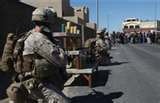
Predeployment Phase
In any operation, the actions you take at the beginning set the stage for the rest of the operation. A NEO is no different. Below are some of the key tasks you want to achieve:
- One of the first key decisions that must be made is if there is a need for a Intermediate Staging Base or ISB. An ISB is established if a location is needed to stage forces before they begin the evacuation of the noncombatants. Thus, an ISB is located at an area located away from the evacuees’ location. This could be another country, the US, or even an island off the coast of the area. If an ISB is required you must begin immediately preparing the area.
- Locate contingency plans and planning documents. In most cases, significant planning has already been conducted. No need to reinvent the wheel.
- Intelligence preparation is critical. You conduct the same analysis of the threat and the environment in a NEO as you do in a conventional fight. IPB is conducted no matter what the mission!
- Set up your command and control nodes as quickly as possible.
- Get out the advance party as soon as possible. They truly set the conditions for success. The party should be small and inconspicuous to avoid drawing attention. It should deploy as far in advance of the main body as possible to allow the maximum time for coordination. Its leader should have the experience necessary to interact effectively with US embassy and higher headquarters. It should carry with it specialized equipment with it to assist the main body.
- Obtains most current list of evacuees and locations. Conducts area reconnaissance to confirm compatibility of the evacuation plan with the host nation’s current situation.
- Determine admin and logistical requirements, especially those relating to evacuee needs.
- Determine support available.
- Imperative within this phase is developing the rules of engagement for the NEO. It is imperative this is done right and everyone completely understands it. With so many organizations involved, the language must be right. Is a lawyer involved in the process? Unquestionably! An error in this area could have disastrous consequences.
One of the key things done in this phase is to organize the force for the NEO. Below are some of the elements that are created.
ORGANIZING FOR AN NEO
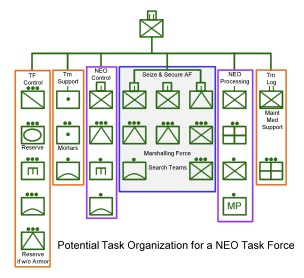
Evacuation force operations organization and mission. The evacuation force can range from the size of a company element to a brigade or larger. The size depends on the number of evacuees, evacuation sites, assembly areas, and the tactical situation. Within this force, you will normally break it up into the following subunits: a command and control element, a marshaling force, a security force, a logistics element, administrative element and reaction force. The size of the security force increases in high threat situations. Let’s discuss each of these.
Command and control (C2) element. The C2 element is the NEO headquarters. It plans and directs operations and has three components; 1) the command group, 2) the staff and 3) the liaison section that maintains communications with the embassy and civilian agencies.
Marshaling force. The marshaling force is the operational element, all other elements support it. It secures the assembly areas, brings evacuees there, and escorts them to the Evacuation Control Center (ECC). The size of the marshaling force depends on the number of sites and evacuees. The force will be broken into marshaling teams which control the assembly areas and evacuees in them. Each team has a command group, search squads, and security squads. Let’s talk about each of these.
- The command group includes the team commander, a processing section, and an interpreter. It plans and directs movement, security, the search for evacuees, and the return to the ECC.
- The search squads find the evacuees and escort them to the assembly area.
- The security squad provides protection during movement and in the assembly area. If available, Special Operations Forces may be attached to facilitate communications with locals, support the security and search teams and provide culture and language expertise.
Security force. The security force is the third element of the evacuation force. They secure the ECC and evacuation site and man a reaction force. They establish a defensive perimeter around the ECC, control entry, provide early warning and control personnel inside the perimeter. They deploy with barrier material and nonlethal crowd control.
Logistics element. The logistics element provides the minimum support required for a short-duration mission. The HN may provide support, but the deploying force plans to be self-sustaining (never depend entirely on the HN). Logistics is limited to that which sustains life and mission support, transportation and maintenance.
Administrative element. The admin element runs the processing center’s six stations: reception, registration, debriefing, medical, embarkation and comfort. We will discuss these later. A consular section collocates with the admin element to aid evacuee processing. The reception station should have male and female MP’s for search and to escort through the center. A medical station addresses special needs while logistics personnel run a comfort station and embarkation station. Counterintelligence and/or civil affairs teams run the debriefing station.
The reaction force is the NEO reserve that responds to crises. Their size depends on their assigned missions, the situation and the degree of HN’s support and transportation requirements.
This is just a small percentage of the things needed to be done during predeployment.
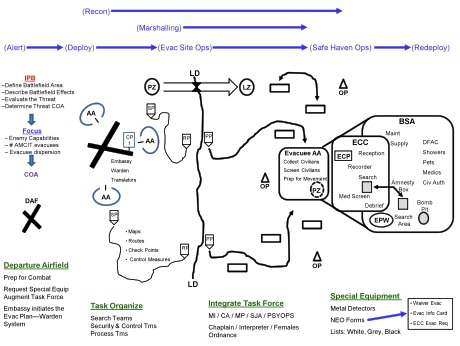
A Potential Layout for an Evacuation Site
Deployment Phase
Within the deployment phase, there are two key things that take place. First, the ISB (if required) is completed and ready to accept the forces that will conduct the evacuation. This can be a significant endeavor in itself. The ISB should be equipped with everything the evacuation force needs to prepare for the evacuation. As a side note, the ISB can also be used as the location where the evacuees are ultimately taken once they are rescued (safehaven).
The second action is for the evacuation force to move to the locations where they will linkup with the evacuees. There are generally three courses of action for the linkup. First, the evac force can deploy to a central area (we call this the Evacuation Control Center or ECC). At the ECC, the marshaling force will then move to collect the evacuees and bring them back to the ECC. Second, the evac force (specifically the marshaling force) is directly deployed to assembly areas where they will then move to the evacuees’ location. Third, the evac force deploys directly to the ECC and waits for the evacuees to come to them. Once they arrive, they will then be evacuated. The determination on what course of action to execute is dependent on numerous factors.
Evacuation Phase
The link-up between the evacuation force and the evacuees can be a challenge. This can be an extremely chaotic situation. Communication between the two must be clear and without interruptions.

There are two options in conducting the evacuation:
Nighttime evacuation avoids publicity, reduces the confrontation, exploits curfews and faces reduced traffic. On the other hand, teams can get lost or struggle to find evacuees. Day evacuation avoids densely populated areas, main arteries, and road blocks.
Marshaling force operations. The marshaling force locates evacuees, conducts link-up and then moves to assembly areas. From the assembly areas they will then move them to the ECC. The teams follow the designated routes to their assembly areas where they establish a base of operation. The marshaling teams make as many trips as necessary to service their assembly areas. If the commander decides not to send out search squads, the marshaling teams remains in their assembly areas awaiting evacuees to come to them. After waiting a suitable amount of time the marshaling team may send out search squads to find AMCITs that have not appeared.
Transportation. Transportation options include helicopter, vehicle, and foot. Teams moving on foot reduce vulnerability by moving tactically to reduce separation and enhance control. Vehicular movement is preferred. Drivers must know the primary and alternate routes and must carry maps. Safe houses are identified for use if vehicles break down. A mechanic goes along to make emergency repairs. The commander decides whether to repair or to abandon broken down vehicles, but the team cannot allow anyone to remain with a vehicle without security.
Movement control. The marshaling force monitors team movement and location. Teams report the movement of the search squads using coded checklists to enhance security. The basic functions in the assembly area are to secure the area, assemble evacuees and begin processing them for evacuation. The marshaling team clears and occupies the assembly area tactically and, once security is in place, denies entry inside the perimeter without an escort.
Dispatching Search Squads. Search squads are manned with trained and disciplined soldiers capable of dealing with civilians under stress. Soldiers and leaders must be calm and able to interact with civilians. The marshaling team dispatches the search squads based on the evacuee list. If the embassy has communicated with the AMCITs, they will know evacuation is necessary and will know what to do. Inevitably, some people will hear about it and search squads must find them. Loudspeaker and civil affairs teams can help. If all evacuees have been informed the commander may not have even need search squads since the evacuees will come to the assembly area on their own. If they are needed, the search squads go to the evacuees addresses. If the evacuee is not present, the squad tries to determine their location. Each search squad has a list of the instructions for the evacuees.
Upon making contact, the squad leader finds out if the evacuee wishes to go or stay. If someone decides to stay, the squad leader repeats the ambassador’s warning that the embassy cannot assist evacuees if it closes. The squad leaves a point of contact and has the evacuee sign a waiver if he still will not evacuate. The purpose is to prove that the evacuee was given a chance to depart under protection and has refused. If he won’t sign then the date, time and circumstances are recorded. Government employees and their dependents cannot disregard an evacuation order.
Evacuees must have documentation and identification. Documentation includes: passport, consular report of birth, DOD-dependent identification (ID) cards, or seaman’s papers. Unless specified, the search squad does not delay operations due to lack of documentation. Questionable people are segregated and moved to the processing center with other evacuees where embassy personnel can make the final determination.
Search squads may be asked to evacuate aliens or HN nationals such as servants or friends. The commander refers these requests to embassy officials. No one can grant asylum while within the territorial jurisdiction of another state but the commander can grant refuge to person(s) in imminent danger. Such decision may trigger retribution and must be weighed against the potential danger. An embassy representative must assume responsibility for these individuals.
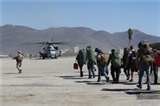
Processing Evacuees. While the security force prepares positions and search squads deploy, the command group prepares to take in evacuees. Teams identify the evacuees as they arrive and discover their medical issues. The security team bars entry to anyone lacking positive identification. Team commanders resolve discrepancies and embassy personnel are the final arbiters of disputed identity.
Evacuees must submit to searches before entering the assembly area, but they are treated with the courtesy at all times. Amnesty boxes are provided for the disposal of contraband. Teams avoid physically intrusive searches unless such procedures are deemed necessary for security. Metal detectors and dogs can be used without demeaning evacuees. Disputes over baggage, speed movement, confiscation of contraband, or deportment of specific individuals may arise. The marshaling team must remember that they have no legal jurisdiction over US citizens and cannot force them to do anything against their will unless being threatened with bodily harm.
The relationship between the escorts and the evacuees is one of cooperation. If a citizen becomes disruptive, the team commander gives him the choice of following the rules or fending for himself. The team commander cannot endanger the welfare of the other evacuees to accommodate a malcontent.
Personnel with excess baggage are counseled on the restrictions but they are allowed to carry their bags if transportation can carry it to the processing center. Once there, the embassy can arrange for its disposition. Evacuees separated from their baggage are given receipts. Evacuees with high-value items are warned that the government will not assume responsibility for them.
The next step in processing is to record the evacuee information. The information includes; name, age, sex, citizenship, identification, next of kin and/or permanent home address. Once the team makes the required entries in the log book the commander briefs the evacuees. He provides a situation report, the evacuation schedule and other useful information. He makes them feel comfortable, but also cautions them against distracting the security personnel. Once the listed evacuees are accounted for the commander requests permission to close out the assembly area and return to the ECC. Once there, they head to the processing center where the commander hands his charges and his log book to the reception station for processing and embarkation.

ECC Operations.
When the marshaling team hands off the evacuees to the ECC the processing center takes over.
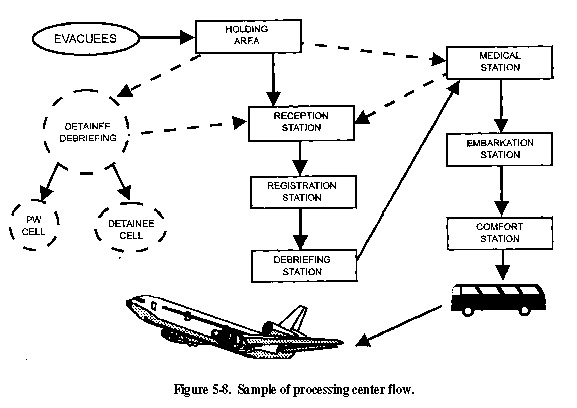
Let’s discuss the stations an evacuee will make one they arrive at the ECC.
Reception Station. As evacuees arrive at the ECC, the Commander of the ECC collects all available information from the marshaling teams who escorted them. The evacuees then move into a holding area where they are briefed again. They are organized into flight groups, searched for contraband, and are escorted through the stations. Evacuees suspected of being enemy agents or criminals are separated for interrogation by intelligence personnel, at the conclusion of which they are allowed to continue processing or are placed into a detainee holding area.
Registration Station. At the registration station, evacuees complete the paperwork required to depart the country. They prove their identity, sign a register, and complete the evacuee identity card. When time permits, they are photographed. Foreign nationals must be on the evacuee list or must have secured embassy approval before they continue processing. Registration personnel supervise foreign nationals until they are cleared for evacuation or escorted out of the ECC. If available, military police should be stationed here to react to hostile incidents. Tempers can certainly flare at this station.
The Embarkation Station uses the evacuee register for final manifesting. Each evacuee fills out an evacuation information card listing next of kin and any requirements that might affect the health and safety of him or others. Each evacuee gets a copy of the Repatriation Processing Sheet to be completed before arrival at the repatriation center.
Debriefing Station. The debriefing station is optional, depending on the situation and time available. It is manned by counterintelligence or civil affairs personnel. Each evacuee is debriefed to glean information that may affect the evacuation force, the mission, other evacuees, or activities in the country. Other desired information includes the movements and activities of belligerents, locations of other evacuees and changes in the situation. If time is not available, this will be conducted at the safehaven.
Medical Station. The medical station provides emergency medical treatment and immunizations required by the safe-haven destination. Every evacuee goes through the medical station where he describes his state of health and emergency medical needs. Serious cases have priority for evacuation.
Embarkation Station. Personnel at the embarkation station manifest the evacuees, issue boarding passes, and verify baggage tags. The embarkation station ensures that information on the manifest agrees with information on the evacuee register when preparing the final manifest. They also provide an escort to each chalk. He accompanies the group to the comfort station and keeps them together until the transport is ready to receive them. He coordinates evacuee requirements with the comfort station to make the waiting time comfortable.
Comfort Station. The comfort station is the evacuees wait to board their evacuation aircraft. The station provides some privacy and maintains shelter, cots, blankets, latrines, water, infant supplies, and food to make the evacuees’ comfortable. Chaplain’s counsel distressed evacuees.

Withdrawal Phase
Withdrawal of evacuation force. Once the marshaling teams return and no evidence exists that the force must evacuate others, the commander notifies headquarters that the evacuation phase is complete. The commander then asks the senior DOS representative if he can begin his withdrawal. After receiving permission to withdraw, the commander departs his force quickly. Soldiers should be the only persons remaining although the ambassador or senior military attaché may wish to stay until the last man departs.
The situation in the HN may be deteriorating and locals will know that the Americans are leaving; factors that increase possibility of an attack. Once the civilians depart, the evacuation force assumes a defensive position until the last unit departs. Support elements depart first. The commander then moves his force to the least exposed portion of the airfield or port and he deploys a security team to protect aircraft on final approach. Pilots use deception tactics as long as possible before landing and as soon as possible after taking off. A technique for the security force is to evacuate all but one rifle company that departs last in one lift. If the situation deteriorates, nonessential equipment may be left behind. Doing so can lead to a propaganda coup so this action is only done under dire circumstances. Once the entire force has departed, the commander notifies his boss that the evacuation is complete. If another mission exists for it, the commander adjusts accordingly.
Safehaven Phase
The evacuees are now in safe hands. It is now time to move them away from the country. We call this area the safehaven. This location is determined by Department of State in an area or country to which evacuees may be moved quickly and easily. The ideal location for the safehaven would obviously be in the United States. However, that may not be feasible. As we discussed earlier, the safehaven could be the ISB you established early in the operation.
The goal of the safehaven is to effectively transition the evacuees essentially back into a normal existence. Certainly, they have been through a significant ordeal and this can be a challenge. The safehaven is organized similar to the ECC during the evacuation phase. You will try to organize into the following sub elements:
- The Command Team
- The Reception Team
- The Processing Team
- The Comfort Team
- The Scheduling Team
- Security
Let’s discuss each:
The Command Team – As you can surmise, this is the Commander of the unit running the safehaven and his special staff. He is responsible for all that goes on (or doesn’t go on) at the safehaven. Especially critical in this team is the chaplain for obvious reasons.
The Reception Team. Once the evacuees arrive at the safehaven, they are met by the reception team. The reception team is comprised of two sub elements. The first is the briefing section. Their responsibilities include meeting the evacuees once they arrive. They will discuss with them many things including the current situation in the host nation, how the safehaven is run and its objectives, what the future will bring in terms of getting home and projected departure times. The other sub element is the public affairs section. They will ensure all media operations are conducted in the best interest of everyone concerned.
The Processing Team. The processing team has a variety of missions. They conduct all the admin requirements of the evacuees, they will start arranging for transportation to get the evacuees home, will debrief the evacuees and collect any relevant intelligence,, and conduct medical exams of the evacuees. Clearly, this is an important team.
The Comfort Team. The comfort team runs the logistics support for the safehaven. This includes food, billeting, supplies, sanitation, and transportation.
The Scheduling Team. It is here where the transportation plans are finalized and eventually executed. They will get the evacuees on their planes once everything that is required within the safehaven is completed.
Security. There is always a security element to ensure no one gets in or departs the safehaven unless authorized.

REVIEW
The entire operation is conducted as rapidly and as thoroughly as possible. If a solid evacuation plan already in place and there has been sufficient warning then the operation should be relatively fast. The overall complexity is wholly dependent on the nature of the environment, level of HN cooperation, and hostility to US personnel of any belligerents. A NEO mission is precise and units who execute it are normally trained for it. The USMC and US Army Airborne units typically have NEO as part of their training cycle. Rehearsals and back-briefs are essential to success. If you get this mission, be prepared and be quick. The speed of the operation often determines the degree of success
NEXT MONTH
In our next article, we will shift into a mini-series on reconnaissance operations. We will begin by discussing the fundamentals of recon to set the conditions for you. Future articles will then key on the planning, preparation and execution of reconnaissance operations. Obviously, this is important stuff on any battlefield and we will do the subject justice!

